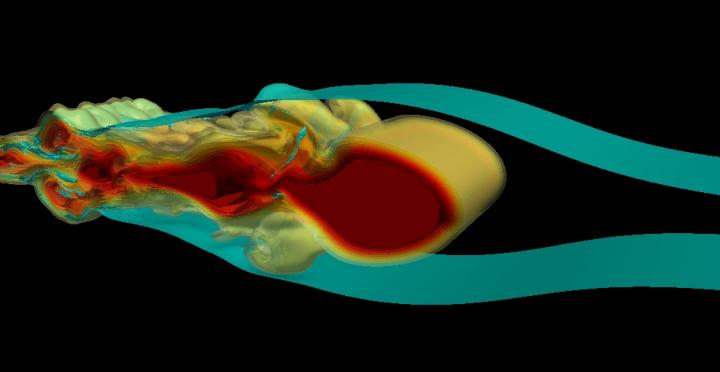3-D model reveals how invisible waves move materials within aquatic ecosystems

Garbage, nutrients and tiny animals are pushed around, suspended in the world's oceans by waves invisible to the naked eye according to a new 3-D model developed by mathematicians at the University of Waterloo. The image shows the 3-D model of mode 2 internal waves. Credit: University of Waterloo
David Deepwell, a graduate student, and Professor Marek Stastna in Waterloo's Faculty of Mathematics have created a 3-D simulation that showcases how materials such phytoplankton, contaminants, and nutrients move within aquatic ecosystems via underwater bulges called mode-2 internal waves.
The simulation can help researchers understand how internal waves can carry materials over long distances. Their model was presented in the American Institute of Physics' journal Physics of Fluids earlier this week.
In the simulation, fluids of different densities are layered like the layers of a cake, creating an environment similar to that found in large aquatic bodies such as oceans and lakes. A middle layer of fluid, known as a pycnocline, over which the layers are closely packed together is created, and it is in this layer that materials tend to be caught.
“When the fluid behind the gate is mixed and then the gate is removed, the mixed fluid collapses into the stratification because it is both heavier than the top layer and lighter than the bottom one,” explained Deepwell, “Adding dye to the mixed fluid while the gate is in place simulates the material we want the mode-2 waves – the bulges in the pycnocline formed once the gate is taken away – to transport. We can then measure the size of the wave, how much dye remains trapped within it, and how well the wave carries its captured material.”
Deepwell and Statsna found that the larger the bulge within the pycnocline, the larger the amount of material carried by the mode-2 wave.
While they have discovered an optimal scenario in which the mode-2 internal wave survives and then transports material for as long a distance as possible, the internal waves can also break down due to small regions of instability, called lee instabilities, that form behind the wave. When the mode-2 wave breaks down, material is lost behind the wave. Ongoing experimental work and simulations are exploring how this type of wave interacts with underwater topography like sea mounts.
###
About the University of Waterloo
University of Waterloo is Canada's top innovation university. With more than 36,000 students we are home to the world's largest co-operative education system of its kind. Our unmatched entrepreneurial culture, combined with an intensive focus on research, powers one of the top innovation hubs in the world. Find out more at uwaterloo.ca
Media Contact
All latest news from the category: Materials Sciences
Materials management deals with the research, development, manufacturing and processing of raw and industrial materials. Key aspects here are biological and medical issues, which play an increasingly important role in this field.
innovations-report offers in-depth articles related to the development and application of materials and the structure and properties of new materials.
Newest articles

Properties of new materials for microchips
… can now be measured well. Reseachers of Delft University of Technology demonstrated measuring performance properties of ultrathin silicon membranes. Making ever smaller and more powerful chips requires new ultrathin…

Floating solar’s potential
… to support sustainable development by addressing climate, water, and energy goals holistically. A new study published this week in Nature Energy raises the potential for floating solar photovoltaics (FPV)…

Skyrmions move at record speeds
… a step towards the computing of the future. An international research team led by scientists from the CNRS1 has discovered that the magnetic nanobubbles2 known as skyrmions can be…





















